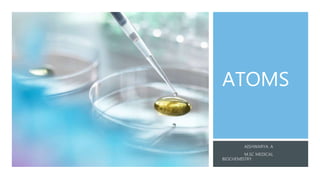
Atoms
- 1. ATOMS
- 2. CONTENT WHAT IS ATOM? STRUCTURE OF ATOM ATOMIC MODELS ORBITALS MASS NUMBER & ATOMIC NUMBER ISOTOPES
- 3. WHAT IS ATOM ? An atom is the smallest unit of ordinary matter that forms a chemical element. Atom, smallest unit into which matter can be divided without the release of electrically charged particles. Electric charge: zero (neutral), or ion charge. Atoms are made out of three basic particles : Protons, Neutrons and Electrons.
- 4. STRUCTURE OF ATOM JOHN DALTON’S MODEL John Dalton was an English scientist, who came up with an idea that all matter is composed of very small things. It was the first complete attempt to describe all matter in terms of particles. He called these particles atoms and formed an atomic theory. In this theory he claims that: 1. All matter is made of atoms. Atoms are indivisible and indestructible 2. All atoms of a given element are identical in mass and properties 3. Compounds are formed by a combination of two or more different kinds of atoms 4. A chemical reaction is a rearrangement of atoms
- 5. J.J. THOMSON’S MODEL • J.J. Thomson's experiments with cathode ray tubes showed that all atoms contain tiny negatively charged subatomic particles or electrons. • Thomson's plum pudding model of the atom had negatively-charged electrons embedded within a positively-charged "soup”.
- 7. RUTHERFORD’S MODEL Based on his experimental results, Rutherford made the following conclusions about the structure of the atom: 1. The positive charge must be localized over a very tiny volume of the atom, which also contains most of the atom's mass. This explained how a very small fraction of the α particles were deflected drastically, presumably due to the rare collision with a gold nucleus. 2. Since most of the α particles passed straight through the gold foil, the atom must be made up of mostly empty space.
- 8. RUTHERFORD’S EXPERIMENTAL SETUP AND NUCLEAR MODEL
- 9. DIFFERENCE BETWEEN THOMSON AND RUTHERFORD MODEL
- 10. BOHR’S MODEL Electrons orbit the nucleus in orbits that have a set size and energy. The energy of the orbit is related to its size. The lowest energy is found in the smallest orbit. Radiation is absorbed or emitted when an electron moves from one orbit to another.
- 11. ATOMIC ORBITALS There are several different orbital shapes—s, p, d, and f The first energy level contains only one s orbital, the second energy level contains one s orbital and three p orbitals, and the third energy level contains one s orbital, three p orbitals, and five d orbitals. Within each energy level, the s orbital is at a lower energy than the p orbitals.
- 12. An orbital diagram helps to determine the electron configuration of an element. An element’s electron configuration is the arrangement of the electrons in the shells. There are a few guidelines for working out this configuration: 1. Each orbital can hold only two electrons. Electrons that occur together in an orbital are called an electron pair. 2. An electron will always try to enter the orbital with the lowest energy. 3. An electron can occupy an orbital on its own, but it would rather occupy a lower-energy orbital with another electron before occupying a higher-energy orbital. In other words, within one energy level, electrons will fill an s orbital before starting to fill p orbitals. 4. The s subshell can hold 2 electrons. 5. The p subshells can hold 6 electrons.
- 13. ATOMIC NUMBER • The total number of protons in the nucleus of an atom gives us the atomic number of that atom. • It is represented with the letter ‘Z.’ • All the atoms of a particular element have the same number of protons, and hence the same atomic number. • Atoms of different elements have different atomic numbers. • For example, all carbon atoms have the atomic number of 6, whereas all atoms of Oxygen have 8 protons in their nucleus.
- 14. MASS NUMBER • The number of protons and neutrons combined to give us the mass number of an atom. • It is represented using the letter ‘A.’ • As both protons and neutrons are present in the nucleus of an atom, they are together called nucleons. • For example, an atom of carbon has 6 protons and 6 neutrons. Thus, its mass number is 12. • While the number of protons remains the same in all atoms of an element, the number of neutrons can vary. Thus, atoms of the same element can have different mass numbers, and these are called isotopes. • The weight of an electron is almost negligible. Thus, the atomic mass of an atom is almost the same as its mass number.
- 15. NOTATION OF ATOMIC AND MASS NUMBER WITH AN EXAMPLE Carbon atom
- 16. ISOTOPES It is as variants of a particular element where these variants will have the same number of protons but differ in the number of neutrons in the atom. There are three isotopes of the element hydrogen: hydrogen, deuterium, and tritium.